Political Cartoons
Introduction
Political cartoons express opinions about public issues and public individuals. They appeal to all levels of readers as even those with minimal reading abilities could understand and relate to a format that communicated powerful ideas in a humorous, enlightened manner. Often the full meaning of the cartoon is too subtle to grasp without first understanding the symbolism used by the cartoonist as well as a knowledge of history and current events. Armed with this background, the reader can apply critical thinking skills to decipher and interpret the cartoonist’s meaning and point of view. Using analogy, irony, symbolism, and exaggeration the cartoonist expresses the themes and problems of their historical era.

(AV-LP889, ALPLM Audiovisual Collection, Digitized thanks to an ISL Grant)
Technology and Changing Tastes
The increase in newspaper and magazine circulation in the 1800’s provided a rich environment for the rise and use of political cartoons. Technological advances in printing in the mid-nineteenth century increased the use of woodcut illustrations in newspapers and magazines, although it was not yet possible to reproduce photographic images in publications. In 1855, the aptly named Frank Leslie’s Illustrated Newspaper, circulated more than 100,000 copies in New York City. People were no longer content to simply read the news, they wanted to see images of it as well, and readers were eager for the entertainment value of seeing politicians and powerful figures parodied and made the butt of public jokes.
President Lincoln and Political Cartoons
American presidents have always been fodder for public scrutiny and ridicule. Political cartoons allow us to experience how Lincoln’s contemporaries portrayed him publicly in illustrated newspapers and periodicals. As with most political cartoons, some are humorous, others degrading and, in many instances, disturbingly racist. For the purposes of this guide and for use in a school setting, we have omitted the cartoons with the most egregious racist imagery.
[Resource 1: Teaching Race: Pedagogy and Practice Please use caution if choosing examples on your own. Warn students before showing racist imagery and only do so with proper preparation and purpose. Create a box including yellow text that links to the resource]
Lincoln lived in a racist society where people in the North and South thought that black people were intellectually and morally inferior to white people. Opposition to emancipation throughout the country was based upon racial fears. Demonic and satanic imagery were often attached to Lincoln’s emancipation efforts. Also evident are traditional criticisms of any wartime president: bankrupting the treasury to support military efforts; abusing presidential authority; trampling upon civil rights; cronyism in the granting of government contracts; and callous disregard for the hardships of the common soldier and their families.
The Election of 1860
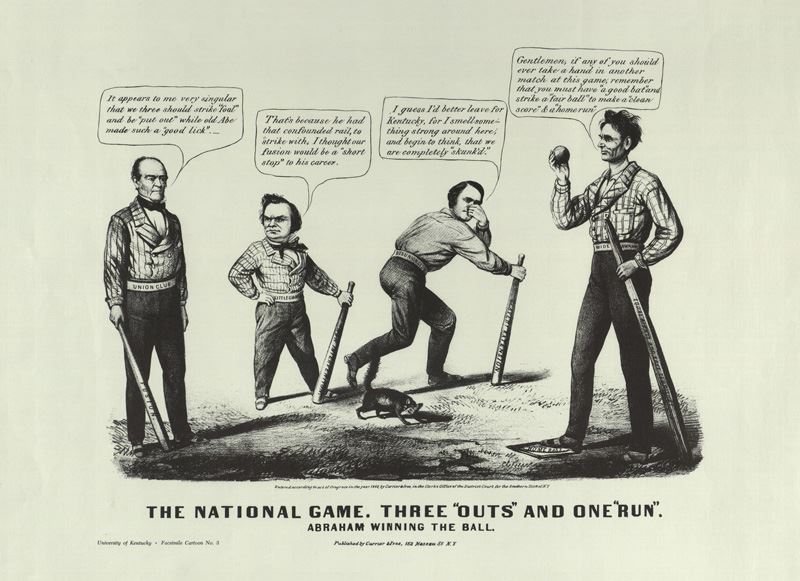
(AV-LP613_c2, ALPLM Audiovisual Collection, Digitized thanks to an ISL Grant)
There were four candidates in the election of 1860 seen in this cartoon from left to right: John Bell (Constitutional Union); and Stephen A. Douglas (Democrat), Vice President under James Buchanan; John C. Breckenridge (Democrat, Southern); Abraham Lincoln (Republican).
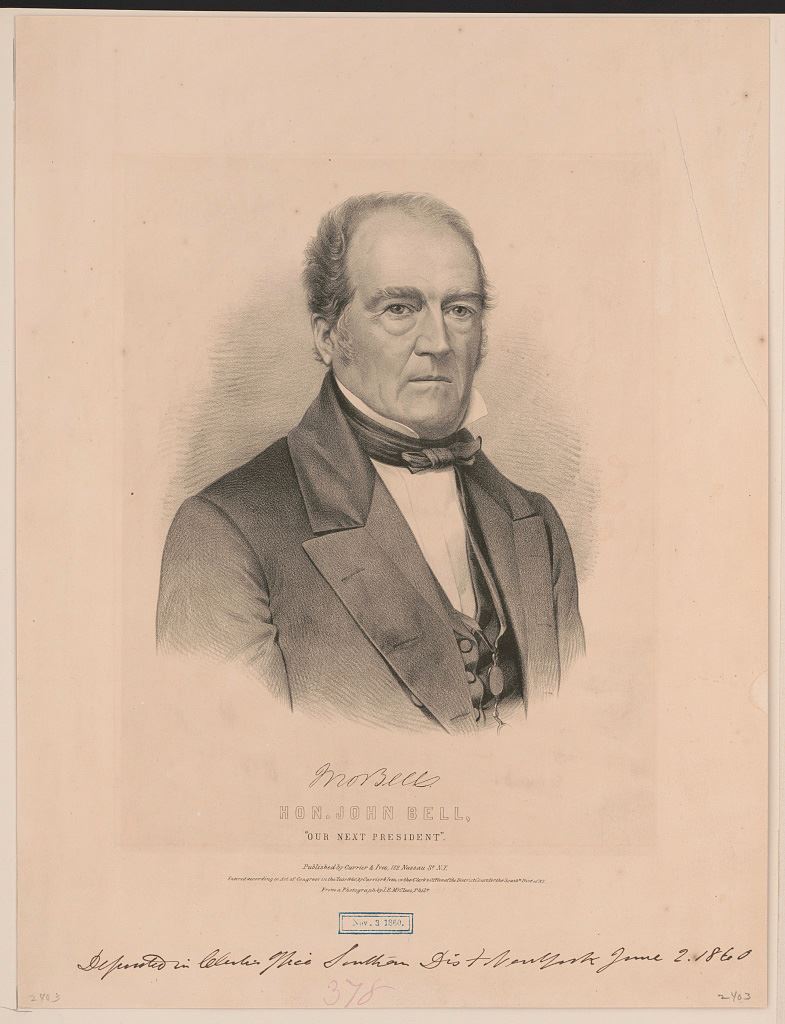
Courtesy of Library of Congress
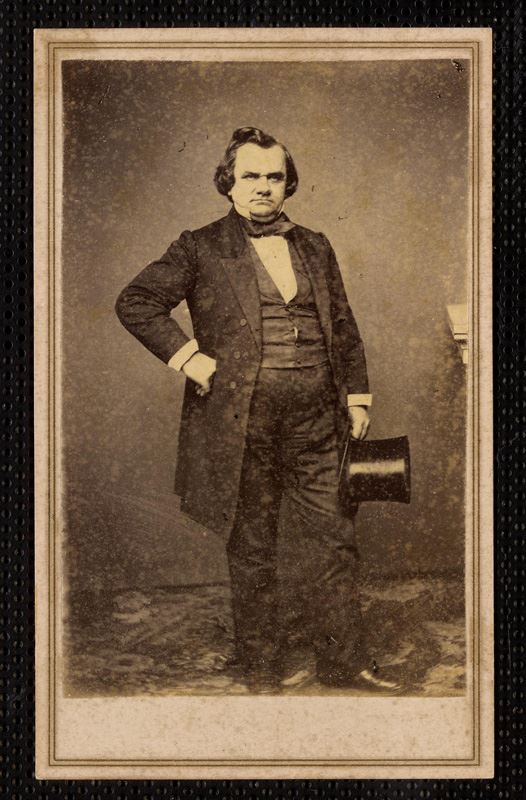
Courtesy of Library of Congress
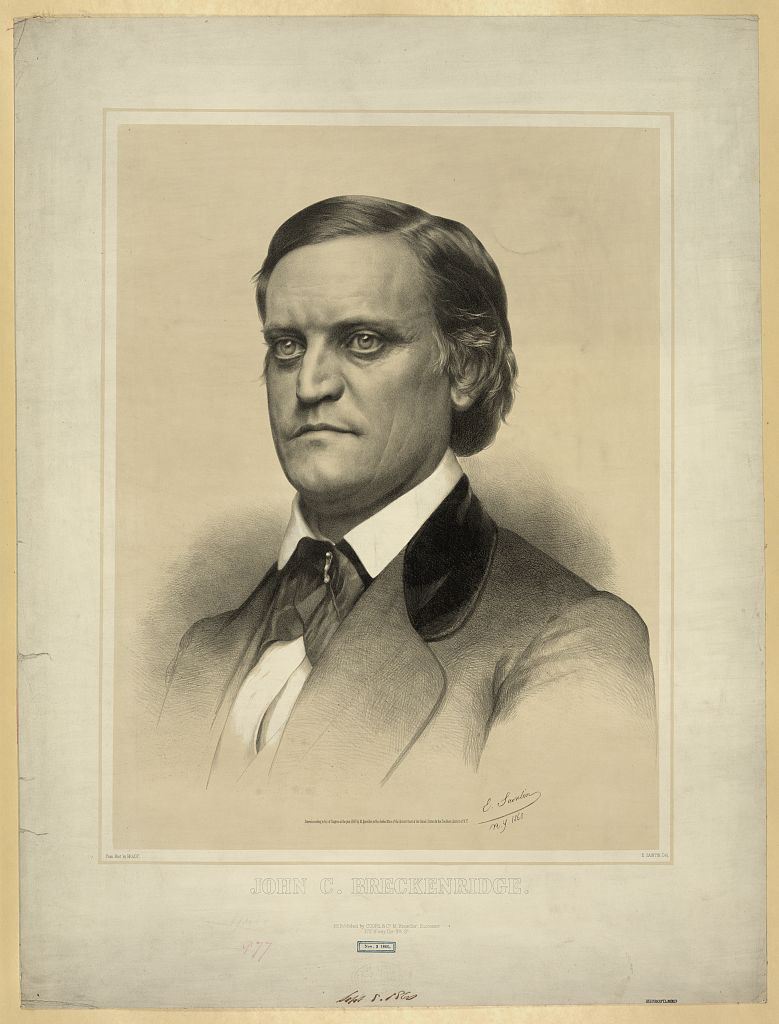
Courtesy of Library of Congress
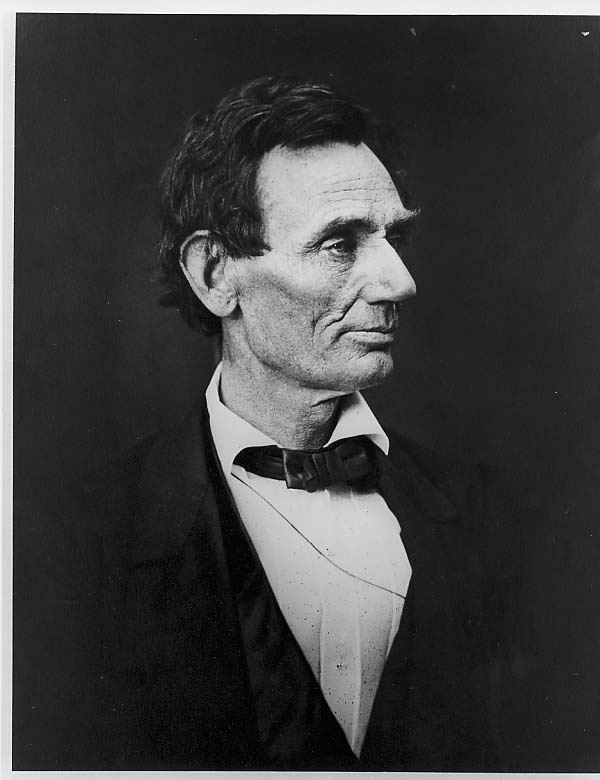
(AV-LPh009_c1, ALPLM Audiovisual Collection, Digitized thanks to an ISL Grant)
The Republican platform stated it would not interfere with slavery in the states but opposed slavery in the territories. It promoted tariffs, a Homestead Act, and a Transcontinental Railroad. The Democratic party was split into Democrat and Southern Democrat. The Democratic platform championed “popular sovereignty” or the right of each state and territory to decide for themselves on the issue of slavery. The Southern Democrats wanted the territories opened to slavery and sought the autonomy to increase their political power through the spread of slavery. The Constitutional Union Party favored a platform where the discussion of slavery was avoided to keep Southern states from seceding. They campaigned to keep everything “as it is”.
This cartoon uses the ‘new’ sport of baseball to satirize the Election of 1860. This artist was kind enough to put all the puns in quotation marks. The animal in the middle is a skunk, though not as visually recognizable without the two white stripes.
Bell wears a belt with “Union Club” written on it. His bat says “Fusion.” His speech bubble reads, “It appears to me very singular that we three should strike ‘foul’ and be ‘put out’ while old Abe made such a ‘good lick’.”
Douglas wears a belt with “Little Giant” written on it. His bat says “Non-intervention.” His speech bubble reads, “That’s because he had that confounded rail, to strike with. I thought our fusion would be a ‘short stop’ to his career.”
Breckenridge wears a belt with “Disunion Club” written on it. His bat says “Slavery Extension.” His speech bubble reads, “I guess I’d better leave for Kentucky, for I smell something strong around here, and begin to think, that we are completely ‘skunk’d’.”
Lincoln wears a belt with “Wide Awakes” written on it. His bat is a rail that says “Equal Rights and Free Territory.” He stands on home base and holds the baseball. His speech bubble reads, “Gentlemen, if any of you should ever take a hand in another match at this game, remember that you must have ‘a good bat’ and strike a ‘fair ball’ to make a ‘clean score’ and a ‘home run’.”
Lincoln was known as “The Railsplitter” to refer to manual labor he did while living on the frontier.
Short Stop is a position in baseball. Foul ball is when you hit a ball outside of the base lines.
Skunk rule or later known as the mercy rule – a team is skunked when there is no way they can win.
The Wide Awakes were a Republican political organization made up mostly of young people dedicated to electing Lincoln into office and encouraging other young people to vote. The Little Giants were a similar group that backed Douglas.
Fusion refers to a political tactic common to the era where political candidates combine their efforts in certain states to beat the opposition for control of the electoral college. The “Old Man” is President James Buchanan.
Using this information, assess two more cartoons about the campaign.
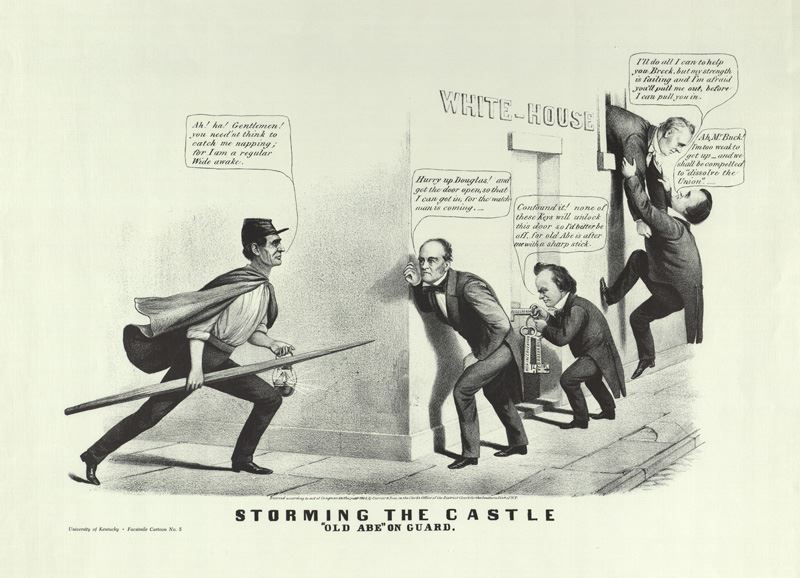
(AV-LP600_c1, ALPLM Audiovisual Collection, Digitized thanks to an ISL Grant)
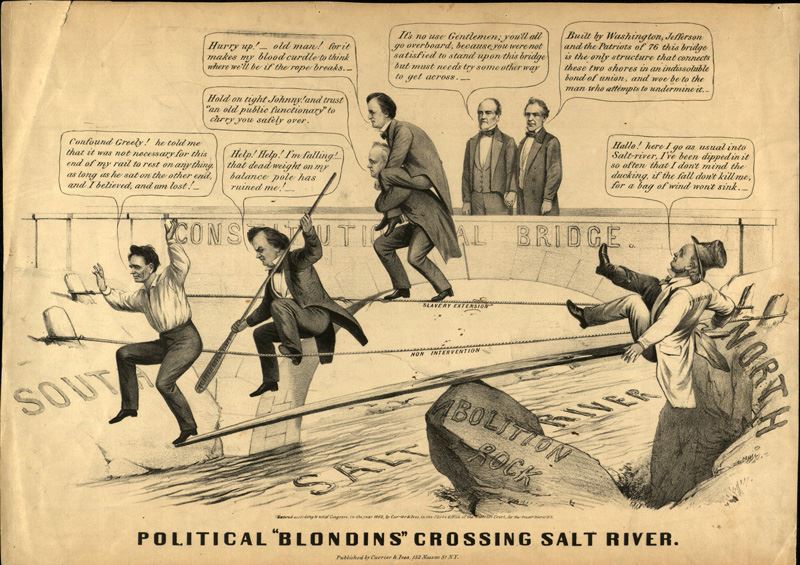
(AV-LP602_c1, ALPLM Audiovisual Collection, Digitized thanks to an ISL Grant)
(Note: Charles Blondin was a French tightrope walker who crossed Niagara Falls. Greely was an abolitionist, politician, and editor of the New York Tribune. John Bell is joined by running mate Edward Everett on the bridge.)
Mr. Lincoln Goes to Washington
Abraham Lincoln left Springfield, IL on February 11, 1861 for his inauguration in Washington, D.C. The train trip was designed as a tour where Lincoln could give speeches and allow the public to see their new president-elect. Lincoln had received threatening letters and reports of groups wishing to harm him from the time of the election months before. After his stops in Philadelphia and Harrisburg, PA, however, the threat became more imminent. A plot to assassinate president-elect Lincoln in or around Baltimore, MD had been uncovered by Allan Pinkerton and associates infiltrating a disgruntled group of pro-secessionists.
One of Pinkerton’s best agents, Kate Warne, assisted the president-elect in leaving the train he was publicized to ride and boarding a different train bound for Washington D.C. under the pretense of being her sick brother in need of privacy and rest. This allowed Lincoln to pass through Baltimore and arrive in Washington ahead of the scheduled time and avoid danger.
[Image 9: Lincoln on a Train]
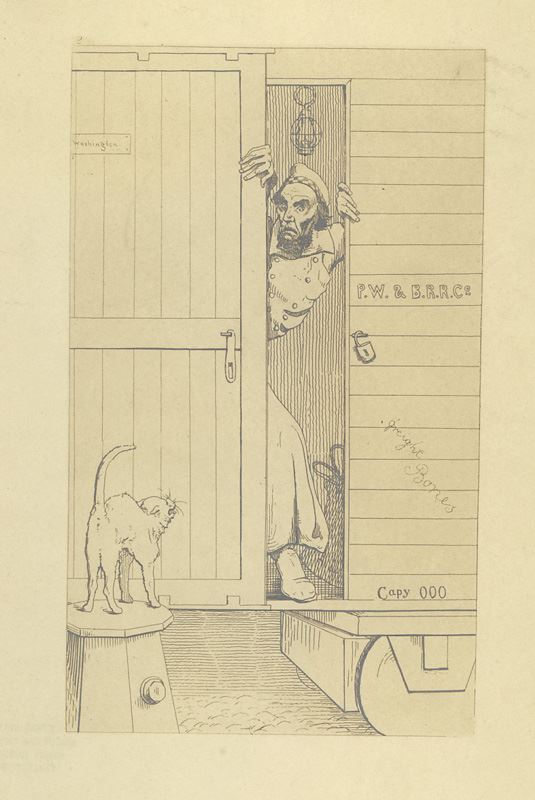
(AV-LP1391, ALPLM Audiovisual Collection, Digitized thanks to an ISL Grant)
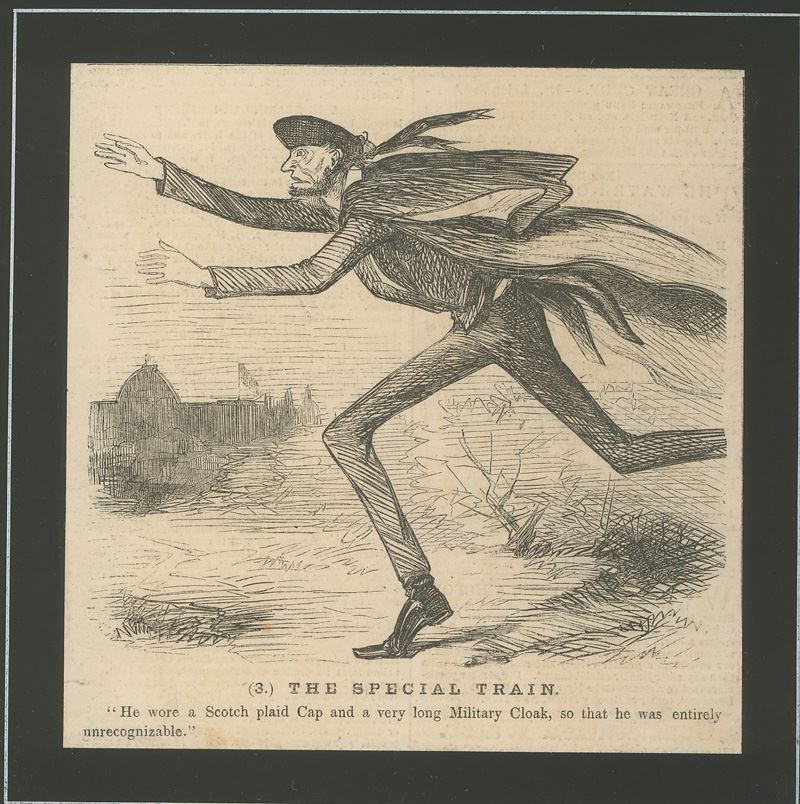
(AV-LP869, ALPLM Audiovisual Collection, Digitized thanks to an ISL Grant)
The political cartoons depicting Lincoln in a “Scotch plaid cap and a very long military cloak” were derived from a false report by the New York Times. It is not known where the reporter received this false information, but Pinkerton reported in his record book that Lincoln wore a “soft hat,” purportedly made of beaver, and “a shawl.”
One of the implications by those opposed to Lincoln is that he is cowardly, and this outfit becomes a signal for that supposed cowardice.
[Resource 2: NYT18610225_Lincoln arrived in Washington.pdf] www.nytimes.com
The Re-election Nightmare
*Warning: racist imagery*
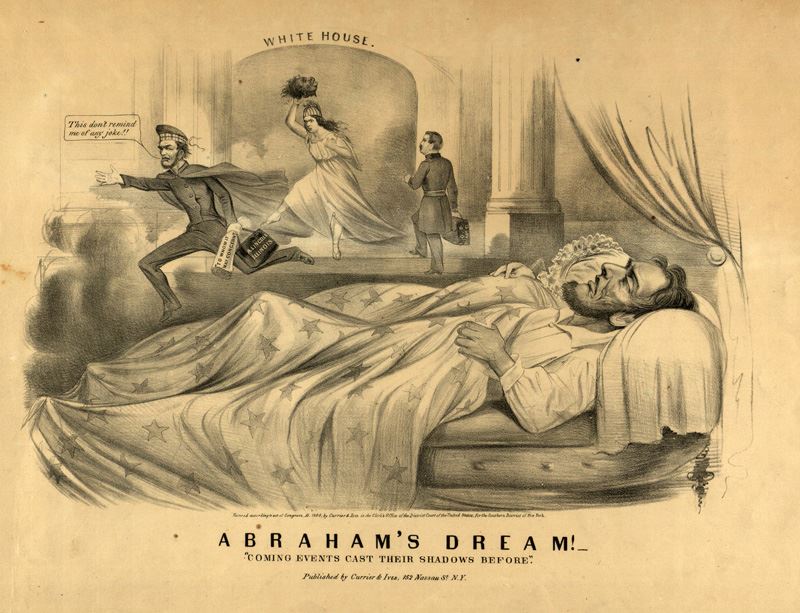
(AV-LP599, ALPLM Audiovisual Collection, Digitized thanks to an ISL Grant)
This Currier and Ives illustration of “Abraham’s Dream!” would have more likely in modern times be called Abraham’s Nightmare. The cartoon would have been published in the autumn of 1864 ahead of the election. Some of the imagery in this cartoon is clear while other parts need to be deciphered.
As previously discussed, the use of the Scotch cap is a symbol for cowardice. His quip about a joke, his case that says Illinois, and the rolled-up document all represent previous jabs about Lincoln’s folksy and frontier manner. Columbia, the woman representing the United States, appears to be running Lincoln out of the White House while holding a severed head of an African American. This severed head represents the rejection of the American people of the Emancipation of enslaved peoples in rebel states and potential rejection of his introduction of the 13th Amendment to the constitution.
If you look closely on the case carried by the other man, it says “G. B. McC” standing for George B. McClellan. Lincoln removed McClellan from service in the U.S. Army after he failed to lead his troops in pursuit of Lee following the Battle of Antietam. McClellan went on to be the Democratic candidate for the presidency in the 1864 election against Lincoln.
In summary, Lincoln fears losing the election due to a poor public opinion, failing to complete his promise of freedom to the African American populace, and ultimately failure to reunite the country by successfully ending the war.
Conclusion
Political cartoonists use the tools at their disposal to communicate visually about the events of the day. These tools can be current events, pop culture, symbolism, exaggeration, and comedy. There is something compelling about seeing the past rather than reading about it. Interpreting these cartoons can be a fun way to learn about the past in bite-sized pieces, with each reference becoming a small window into our past.
Resources
Mann, Lina. “Spies, Lies and Disguise.” WHHA (en-US). Accessed June 13, 2024. https://www.whitehousehistory.org/spies-lies-and-disguise-abraham-lincoln-and-the-baltimore-plot#:~:text=Disguised%20by%20his%20hat%20and,departure%20could%20not%20reach%20Baltimore.
Widmer, Edward L. Lincoln on the Verge Thirteen Days to Washington. New York: Simon & Schuster, 2021.
https://lccn.loc.gov/2021669461